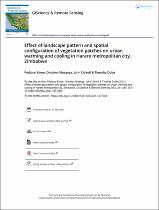Effect of landscape pattern and spatial configuration of vegetation patches on urban warming and cooling in Harare metropolitan city, Zimbabwe
Abstract
The spatial configuration of vegetation patches in the landscape has implications for the provision of ecosystem services, human adaptation to climate change, enhancement, or mitigation of urban heat island. Until recently, the effect of spatial configuration of vegetation to enhance or mitigate urban heat island has received little consideration in urban thermal assessments. This study examines the impact of spatial configuration of vegetation patches on urban thermal warming and cooling in Harare metropolitan city, Zimbabwe. The study used Advanced Spaceborne Thermal Emission and Reflection Radiometer (ASTER), Landsat and Sentinel 2 data acquired between 1994 and 2017 to derive detailed information on vegetation patches, landscape metrics, and land surface temperature LST(°C). The spatial configuration of urban vegetation patterns was analyzed using landscape metrics in Fragstats program. Getis Ord Gi* as a Local Indicator of Spatial Association (LISA) was used to characterize the spatial clustering and dispersion of urban vegetation patches. Results of the Getis Ord Gi* showed that clustered vegetation lowers surface temperatures more effectively than dispersed and fragmented patterns of vegetation. The size, density, shape complexity, and cohesion of vegetation patches conferred different levels of cooling but Patch Cohesion Index had the strongest negative relationship with LST(°C) at three spatial resolutions of 10 m (Sentinel 2), 15 m (ASTER) and 30 m (Landsat 8). The Spatial Lag Regression model performed better than the Ordinary Least Squares regression analysis in exploring the relationship between LST(°C) and landscape metrics. Specifically, the Spatial Lag Regression model showed higher R2 values and log likelihood, lower Schwarz criteria, and Akaike information criterion, and reduced spatial autocorrelations. The overall information provides important insights into the provision of larger, connected, and less fragmented urban vegetation patches to derive maximum and higher cooling effects which is critical for urban planning and design approaches for mitigating increasing surface temperatures in cities.

